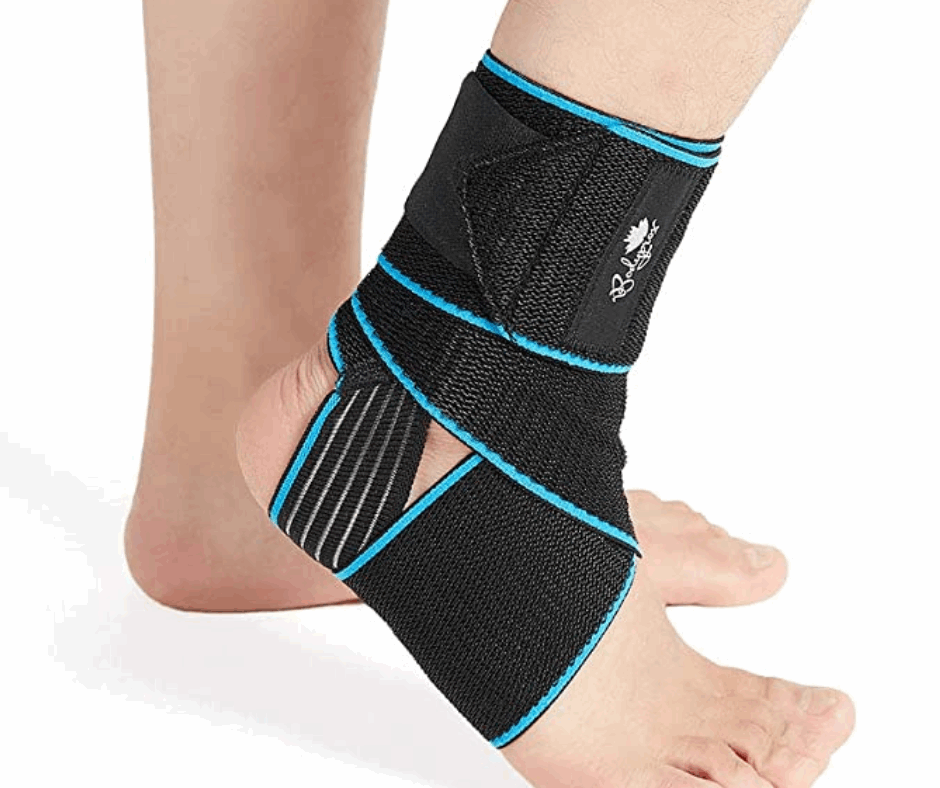1127. Ankle Brace
1127. Ankle Brace
Couldn't load pickup availability
DrSous.Ca
Ankle Brace
|
Size |
1 size |
|
Specific uses for product |
Sprain, Tendinitis, Plantar Fasciitis |
|
Age range (description) |
Adult |
|
Material |
Nylon |
About this item
Prevent injury & soothe discomfort: If you suffer from acute chronic ankle pain from an existing sprain, strain, or sports injury, extra support for the muscle and ankle joint is crucial to the natural healing process. The Bodyprox Ankle Support Brace will help prevent injury or soothe discomfort from an existing condition through compression, stabilization, and lightweight support.
Decreased muscle fatigue & enhanced support: Designed to give you the extra support you need during long bouts of physical activity. It will help stabilize the joint through compression while encouraging proper blood flow to and from the muscles to optimize your performance. Compression will also reduce muscle fatigue through stabilization by minimizing muscular vibration when the muscle/joint repeatedly hits the ground.
Lightweight & non-slip design: Made with moisture-wicking knitted nylon, polyester & elastic blend to keep skin dry and odor-free. It’s crafted with lightweight materials to move with the ankle without restriction, and the strap is adjustable to provide varying degrees of support. Multiple layers of silicone gel are incorporated throughout the brace for our firmest hold yet.
Aids in active recovery: Adjustable compression wrap crosses around the ankle to support the body’s natural movement patterns to prevent further injury and inflammation. Coupled with adequate rest periods, stretching, and strengthening, the Bodyprox Ankle Support Brace will help get you back on your feet.
Designed to fit both feet: Each brace will fit men and women on either foot. This versatile design allows you to customize your desired level of support where you need it most. It fits comfortably into sneakers, skates, winter boots, or work boots and features an open heel design to allow maximum mobility. Comes in a pack of 1 or 2. Put your best foot forward!
Research Study
Ankle injuries are a common occurrence in sports and everyday life. To prevent these injuries, many people turn to ankle braces. An ankle brace is a device worn around the ankle that provides support and stability. In this essay, we will explore the history and evolution of ankle braces, as well as the benefits and drawbacks of using them. We will also discuss how to choose the right ankle brace for your needs. Understanding these key points will help you make an informed decision about whether an ankle brace is right for you.
Ankle braces have been used for centuries to provide support and stability to weak or injured ankles. The first recorded use of ankle braces dates back to ancient Greece, where physicians used animal hides and other materials to create makeshift braces to treat ankle sprains and fractures (Mickel et al. 2006). Over time, the design and materials used in ankle braces have evolved significantly, with modern braces incorporating advanced technologies and materials such as neoprene, carbon fiber, and gel padding. Today, ankle braces are widely used not just by athletes but also by individuals who suffer from chronic ankle instability or have undergone ankle surgery. While ankle braces are effective in preventing ankle injuries and providing support to the ankle joint, they can also cause certain drawbacks such as reduced range of motion and discomfort (Mickel et al. 2006). As such, it is important to choose the right type of ankle brace based on the individual's needs and the level of support required. In conclusion, ankle braces have come a long way from their early roots and are now an essential part of injury prevention and rehabilitation.
Ankle braces have become increasingly popular among athletes and individuals who engage in high-risk activities. Ankle braces are designed to protect the ankle joint from injury and to provide support during physical activities. According to Sharpe, Knapik, and Jones, ankle braces have been shown to reduce the incidence of ankle sprains, which is one of the most common injuries in sports (1997). They also found that athletes who had a history of ankle sprains were less likely to experience a recurrence of the injury when wearing an ankle brace. Furthermore, ankle braces have been shown to be effective in reducing the severity of ankle sprains when they do occur. However, there are also drawbacks to using ankle braces. One of the biggest drawbacks is that they can be uncomfortable and restrict movement. This can be especially problematic for athletes who need full range of motion in their ankle joint to perform at their best. Additionally, ankle braces can create a false sense of security, leading athletes to take unnecessary risks and engage in activities that they would not have attempted without the brace. Overall, ankle braces can be an effective tool for preventing ankle injuries, but they should be used judiciously and with caution.
Ankle sprains are one of the most common musculoskeletal injuries, and their recurrence rate can be as high as 80 percent. After an ankle sprain, the ankle joint is often weakened and unstable, which can lead to chronic ankle instability. Ankle braces are commonly used to prevent and treat ankle injuries. However, choosing the right ankle brace for an individual's needs can be challenging. According to Spitalny (2016), there are several factors to consider when choosing an ankle brace, including the type of injury, the level of activity, and the individual's preference. Ankle braces can be classified as prophylactic or therapeutic, with prophylactic braces designed to prevent ankle injuries and therapeutic braces used to treat existing injuries. The level of activity is also important to consider, as more active individuals may require a brace with increased support and protection. Finally, personal preference is crucial, as the individual must feel comfortable and confident using the brace. By considering these factors, individuals can choose the right ankle brace for their needs, which can help prevent ankle injuries and improve outcomes for those who have already experienced ankle sprains.
In conclusion, ankle braces are an effective tool for preventing ankle injuries and providing support during physical activity. They come in a variety of designs and materials to suit different needs and preferences. Ankle braces can provide added stability for individuals with weak or injured ankles, improving their ability to perform daily activities and participate in sports. It is important to consult with a healthcare professional before using an ankle brace to ensure proper fit and usage. Overall, ankle braces are a valuable investment for anyone seeking to protect their ankles and maintain an active lifestyle.
Work Cited
J Knapik., B Jones."Ankle braces effectively reduce recurrence of ankle sprains in female soccer players."https://www.ncbi.nlm.nih.gov/pmc/articles/PMC1319230/
CR Bottoni."Prophylactic bracing versus taping for the prevention of ankle sprains in high school athletes: a prospective, randomized trial."https://www.sciencedirect.com/science/article/pii/S1067251606004698
"Choosing The Right Ankle Brace For Your Patient."https://www.hmpgloballearningnetwork.com/site/podiatry/choosing-right-ankle-brace-your-patient
Share




